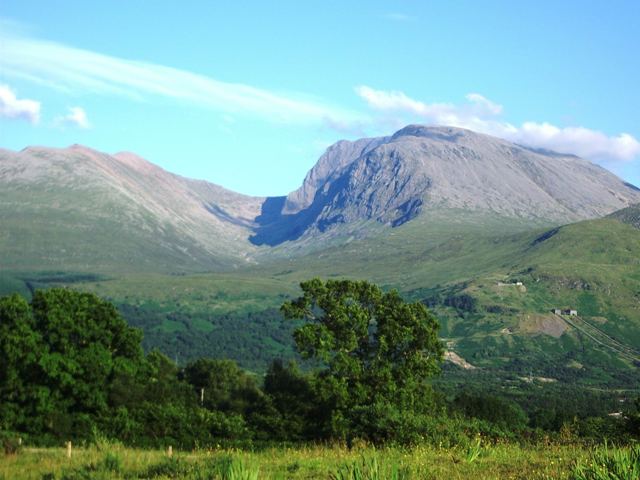
A 1,000 meter-wide bed of rock flew terrifyingly close to the planet, creating fear in the hearts and minds of the scientific community. That fear is known as ‘2014 YB35,’ and is just about the same size as Ben Nevis – a mountain in Scotland that is 1,344 meters (or 4,406 feet) high and has a footprint of about 16km long.
Image Source: Wikipedia – Ben Nevis, from Banavie. The summit is to the left of the highest point.
Now, shooting stars (or meteorites) do regularly pass the Earth, but one of this size is a once in a 5,000-6,000 year appearance, according to scientists. An impact with Earth by a rock of this size would unleash an unstable power force of more than 15 billion tons of TNT!! Any such magnitude would trigger pulverizing changes in the atmosphere, quakes and massive tsunamis, ending the habitation of a lot of, if not all of, life on Earth. It would overshadow the crash created by the 1908 Tunguska Event, which saw a 50 meter piece of extraterrestrial rock crash in Siberia, leveling some 80 million trees and sending a shock wave crosswise over Russia, measuring a 5.0 on the Richter Scale.
Path of asteroid #2014_YB35 missing the Earth.
Image Courtesy: #NASA pic.twitter.com/KDDtvegoCf
— Anon.Dos (@anondos_) May 3, 2015
“This is the genuine danger of a comet or harming space rock hitting Earth,” Bill Napier, professor of astronomy at the University of Buckinghamshire, said. “With something like YB35, we are taking a gander at a size of worldwide demolition, something that would represent a danger to the continuation of the planet. These occasions are however exceptionally uncommon, it is the smaller, yet still extremely harming effects, which are a genuine danger.”
So, the small scale occasions like Tunguska, are a real danger and generally they go undiscovered, thus leaving us unprepared. What’s more, if they were to hit the Earth, there is a possibility that one of the catastrophes would include molten debris being sprayed into the Earth’s atmosphere, making life very difficult here. Smaller pieces of rock could easily decimate urban communities and destroy transport and correspondence systems. Napier added that the real danger is from comets, which, regardless of the fact that they “pass by” the Earth, the tail can produce a monstrous crest of smoke with immensely critical outcomes.
Image Source: NASA – A Sky View of Earth From Suomi NPP. This composite image of southern Africa and the surrounding oceans was captured by six orbits of the NASA/NOAA Suomi National Polar Orbiting Partnership spacecraft on April 9th, 2015.
“There is danger, and on the off chance that you take a gander at history, religious scriptural records have accounts of flames in the sky. Intensely hot particles resulting because of the effect of something a kilometer wide would be able to burn the planet,” stated Napier.
Despite the fact that its actual size is unknown, it was estimated to be between 500 meters and 1 kilometer wide. The object was initially spotted by the Catalina Sky Survey, towards the end of last year. Cosmologists have named June 30th ‘Asteroid Day’ to highlight the threats of ‘Potentially Hazardous Asteroids’ (PHAs) flying through space. Initiative co-founder, Grigorij Richters said, “It just takes one space rock to totally end life of mankind, as well as other species.” The Minor Planet Center has listed the ‘2002 FG7’ and ‘2014 YB35’ as PHAs and NASA has said there are more than 1,500 PHAs in space, which demonstrate a circle perilously near to Earth. A representative said, “Possibly Hazardous Asteroids (PHAs) are, as of now, characterized in view of parameters that measure the space rock’s capability to make debilitating close ways to deal with the Earth.”
Image Source: NASA – Space Station Flyover of Gulf of Aden and Horn of Africa. ESA astronaut, Samantha Cristoforetti, photographed the Gulf of Aden and Horn of Africa from the International Space Station.
This potential to make close approaches to our planet does not mean that a PHA will affect the Earth, it simply means there is plausibility for such a danger. By observing these PHAs, and being updated with their orbit, new estimations become available and they allow us to better foresee the nearby approach measurements.
SOURCES:
http://www.vox.com/2014/9/6/6110441/asteroid-risk-impact
http://tribune.com.pk/story/860383/huge-asteroid-narrowly-misses-earth/
You want to discuss a certain topic with likeminded people or you want to organize a local protest or you have an idea for a project that can help people in need in your local community or all around the world? Join our forum! www.anonboards.com
You want to support Anonymous Independent & Investigative News? Please, follow us on Twitter: Follow @AnonymousNewsHQ








Life on Earth is doomed anyways. As soon as the super-volcano located in yellowstone national park blows (and it’s due any year now), just about all human life will be wiped out. Especially here in the U.S. Asteroids, super-volcanoes, and a sun that’s slowly burning itself out. Unless we venture out into space and begin terraforming other planets, we’re destined to be wiped out at some point in the future.
Um….any year now? You mean sometime within the next what 10,000 years? maybe there’s a hair of a chance? And that’s being generous…get educated.
Yellowstone has been due any day now for the past 200,000 years. It could never blow or it could erupt tomorrow. Saying its due any day now is stupid.
Yeah your right, but until then Let’s all hope we stand a chance on earth. Since I live next to yellow stone
Meteorites do not pass the Earth – they enter the Earth’s atmosphere and burn up creating a ‘shooting star’.
Life is Short
A meteorite is not a meteorite until it hits the earth(or other stable object, i.e., moon or planet) otherwise it is simply a meteor.
If you are going to project your “intelligence” do some fourth grade research first.
if you jumped on a plane when it hits you might live just land after the chaos lol